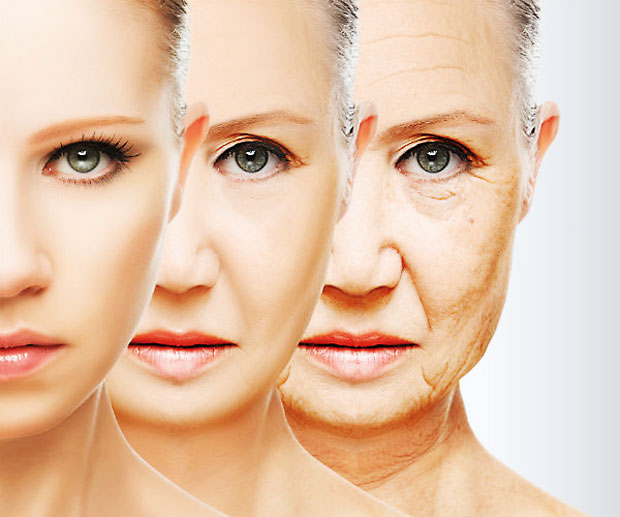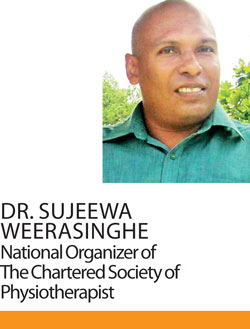Reply To:
Name - Reply Comment

With extended life expectancy, beauty and skin care are important factors in improving the of quality of life. Currently, numerous interventions are offered to rejuvenate the skin. Anti-ageing includes treatments for facial wrinkles, facial muscle tone and elasticity. Recently, physical medicine has been introduced in treatments used for Facial rejuvenation. Facial ageing reflects the dynamic, cumulative effects of time on the skin, soft tissues and deep structural components of the Face. This is a complex synergy of textural changes in the skin and loss of facial volume.
National Organizer of The Chartered Society of Physiotherapist Dr. Sujeewa Weerasinghe was good enough to educate readers on this complex issue by talking to the Health Capsule.

Many of the facial manifestations of ageing reflect on the combined effects of gravity, progressive bone resorption, decreased tissue elasticity and redistribution of subcutaneous fullness. A convenient method of assessing the morphological effects of ageing is to divide the face into the upper third (forehead and brows), middle third (midface and nose) and lower third (chin, jawline, and neck). The midface is an important factor in facial aesthetics because perceptions of facial attractiveness are largely founded on the synergy of the eyes, nose, lips, and cheek bones (central facial triangle). Recent years have seen a significant increase in the number of nonsurgical procedures performed for facial rejuvenation. Such treatment has been obtained by patients seeking nonsurgical procedures, those requiring restoration of lost facial volume, those wishing to enhance normal facial features and those wanting to correct facial asymmetry.
‘’The appearance of the face and neck typically changes with age. Loss of muscle tone and thinning skin gives the face a flabby or drooping appearance. In some people sagging may create the look of the double chin,’’ Dr. Weerasinghe said.
What are the age related changes of the human face?
1. Facial expressions are decreased.
2. Tone and strength of muscles are decreased.
3. Blood supply to the facial soft tissues are decreased.
4. Due to decreased muscle mass and the increase of fat tissues weakens metabolism.
5. Due to low production of oil skin may get drier.
6. Due to gravity, facial movement and sleep position are the secondary factors that contribute to changes in the skin. When the skin loses its elasticity, gravity causes drooping of the eyebrows and eyelids, looseness and fullness under the cheeks and jaw (jowls and “double chin”) and longer ear lobes.
Facial movement lines become more visible after the skin starts losing its elasticity (usually as people reach their 30s and 40s). Lines may appear horizontally on the forehead, vertically on the skin above the root of the nose (glabella), or as small curved lines on the temples, upper cheeks and around the mouth.
Sleep creases result from the way the head is positioned on the pillow and may become more visible after the skin starts losing its elasticity. Sleep creases are commonly located on the side of the forehead, starting above the eyebrows to the hairline near the temples, as well as on the middle of the cheeks. Sleeping on your back may improve these sleep creases or prevent them from becoming worse. Smokers tend to have more wrinkles than nonsmokers of the same age, complexion, and history of sun exposure.
‘’Dry skin and itching is common in later life. About 85% of older people develop “winter itch,” because overheated indoor air is dry. The loss of oil glands as we age may also worsen dry skin. Anything that further dries the skin (such as overuse of soaps or hot baths) will make the problem worse. If your skin is very dry and itchy, see a doctor because this condition can affect your sleep, cause irritability, or be a symptom of a disease. Some medicines make the itchiness worse. Our skin is at the mercy of many forces as we age; sun, harsh weather and bad habits. But we can take steps to help our skin stay supple and fresh-looking,’’ he said.
Ageing of your skin depends on a variety of factors
This depends largely on your lifestyle, diet, heredity, and other personal habits. For instance, smoking can produce free radicals and make healthy oxygen molecules overactive and unstable. Free radicals damage cells and lead to, among other things, premature wrinkles.
There are other reasons, too. Primary factors contributing to wrinkled, spotted skin include normal ageing, exposure to the sun and pollution and loss of subcutaneous support (fatty tissue between your skin and muscle). Other factors that contribute to ageing of the skin include stress, gravity, daily facial movement, obesity and even sleep position.
Skin changes that come with age
As we grow older, changes like the following occur naturally:
Skin becomes rougher. Skin becomes slack. The loss of elastic tissue (elastin) in the skin, with age, causes the skin to hang loosely. Skin becomes more transparent. This is caused by thinning of the epidermis (surface layer of the skin).
Skin becomes more fragile. This is caused by a flattening of the area where the epidermis and dermis (layer of skin under the epidermis) come together. Skin becomes more easily bruised. This is due to thinner blood vessel walls.
Changes below the skin also become evident as we age. They include:
Loss of fat below the skin in the cheeks, temples, chin, nose and eye area. This may result in loosening skin, sunken eyes and give a “skeletal” appearance. Bone loss, mostly around the mouth and chin, may become evident after age 60 and cause puckering of the skin around the mouth. Cartilage loss in the nose causes drooping of the nasal tip and accentuation of the bony structures in the nose.
Sun and facial Skin
Exposure to sunlight is the single biggest culprit in ageing skin. Over a period of time, the sun’s ultraviolet (UV) light damages certain fibers in the skin called elastin. The breakdown of elastin fibres causes the skin to sag, stretch and lose its ability to snap back after stretching. The skin also bruises and tears more easily and takes longer to heal. So while sun damage may not show when you’re young, it will, later in life.
Nothing can completely undo sun damage, although the skin can sometimes repair itself. So, it’s never too late to begin protecting yourself from sun exposure and skin cancer. You can delay changes associated with ageing by staying out of the sun, covering up, wearing a hat and making a habit of using sunscreen.
Skeletal muscle is a fundamental organ in the generation of force and movement and helps in regulating the metabolism of the whole-body metabolism. It also makes provision for resiliency. Indeed, physical medicine and rehabilitation are recognized as essential for optimizing skeletal muscle health in the context of ageing (sarcopenia) and disease (cachexia). Exercise is will remain the cornerstone of therapies to improve skeletal muscle health. ‘’However, now there are a number of promising biologic and small molecule interventions currently under development to rejuvenate skeletal muscle, including my statin inhibitors, selective androgen receptor modulators and an activator of the fast skeletal muscle troponin complex. A Non-surgical Physical medicine solution has been introduced for facial rejuvenation. Developed drainage of waste products and increasing nutrition and the oxygen supply aids blood supply to the skin and muscles of the face. Therapeutic ultrasound treatment that stimulates every muscles of the face, Modified electrotherapeutic treatment together with facial strengthening exercises form the basic foundation for treatment,’’ he added.